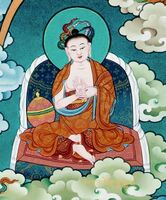Nāgārjuna: Difference between revisions
No edit summary |
No edit summary |
||
| (4 intermediate revisions by 2 users not shown) | |||
| Line 1: | Line 1: | ||
{{Person | {{Person | ||
|HasDrlPage=Yes | |HasDrlPage=Yes | ||
|HasLibPage=Yes | |HasLibPage=Yes | ||
| Line 9: | Line 5: | ||
|HasDnzPage=Yes | |HasDnzPage=Yes | ||
|HasBnwPage=Yes | |HasBnwPage=Yes | ||
|pagename=Nāgārjuna | |||
|PersonType=Classical Indian Authors; Authors of Sanskrit Works | |||
|images=File:Nāgārjuna.jpg | |||
File:Nagarjuna thangka.jpg{{!}}Thangka by Shawo Thar, 2003. View full painting on [https://www.himalayanart.org/items/7827 Himalayan Art Resources] | |||
File:Nagarjuna.jpg{{!}}[http://www.himalayanart.org/ Himalayan Art Resources] | |||
File:PNT Rigdzin Nagarjuna.jpg{{!}}Painting by Pema Namdol Thaye [https://www.padmastudios.com Courtesy of Padma Studios] | |||
|MainNameTib=ཀླུ་སྒྲུབ་ | |MainNameTib=ཀླུ་སྒྲུབ་ | ||
|MainNameWylie=klu sgrub | |MainNameWylie=klu sgrub | ||
| Line 15: | Line 17: | ||
|AltNamesTib=འཕགས་པ་ཀླུ་སྒྲུབ་; སློབ་དཔོན་ཆེན་པོ་ནཱ་གརྫུ་ན་; སློབ་དཔོན་ཀླུ་སྒྲུབ་ | |AltNamesTib=འཕགས་པ་ཀླུ་སྒྲུབ་; སློབ་དཔོན་ཆེན་པོ་ནཱ་གརྫུ་ན་; སློབ་དཔོན་ཀླུ་སྒྲུབ་ | ||
|AltNamesOther=Ārya Nāgārjuna | |AltNamesOther=Ārya Nāgārjuna | ||
|YearBirth= | |YearBirth=ca. 2nd century | ||
|TeacherOf=Śavaripa; Āryadeva | |TeacherOf=Śavaripa; Āryadeva | ||
|BdrcLink=https://www.tbrc.org/#!rid=P4954 | |BdrcLink=https://www.tbrc.org/#!rid=P4954 | ||
Latest revision as of 14:34, 10 January 2024
| PersonType | Category:Classical Indian Authors Category:Authors of Sanskrit Works |
|---|---|
| MainNameTib | ཀླུ་སྒྲུབ་ |
| MainNameWylie | klu sgrub |
| MainNameSkt | Nāgārjuna |
| AltNamesTib | འཕགས་པ་ཀླུ་སྒྲུབ་ · སློབ་དཔོན་ཆེན་པོ་ནཱ་གརྫུ་ན་ · སློབ་དཔོན་ཀླུ་སྒྲུབ་ |
| AltNamesWylie | 'phags pa klu sgrub · slob dpon chen po nA gardzu na · slob dpon klu sgrub |
| AltNamesOther | Ārya Nāgārjuna |
| YearBirth | ca. 2nd century |
| TeacherOf | Śavaripa · Āryadeva |
| BDRC | https://www.tbrc.org/#!rid=P4954 |
| IsInGyatsa | No |
| BnwShortPersonBio | Nāgārjuna was the c. 2nd century founder of the Madhyamaka school of Buddhist philosophy. He is eulogized in the Tibetan tradition as one of the group of great Indian scholars known as the Six Ornaments, though he is equally renown in the Chinese and other East Asian Buddhist traditions. He was the first major Mahāyāna philosopher and his Mūlamadhyamakakārikā became the standard exposition for the Mahāyāna view of emptiness (śūnyatā) as presented in the Prajñāpāramitā Sūtras. |
| Other wikis |
If the page does not yet exist on the remote wiki, you can paste the tag |



